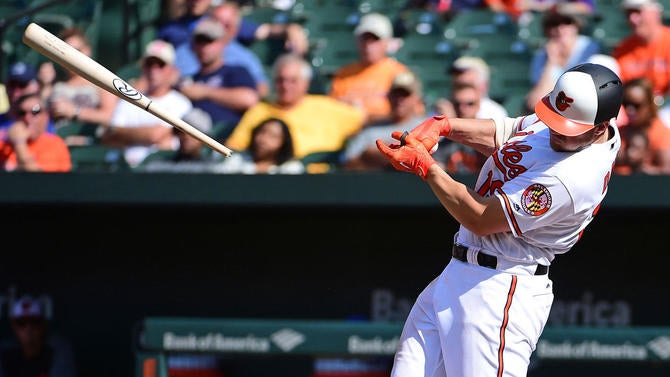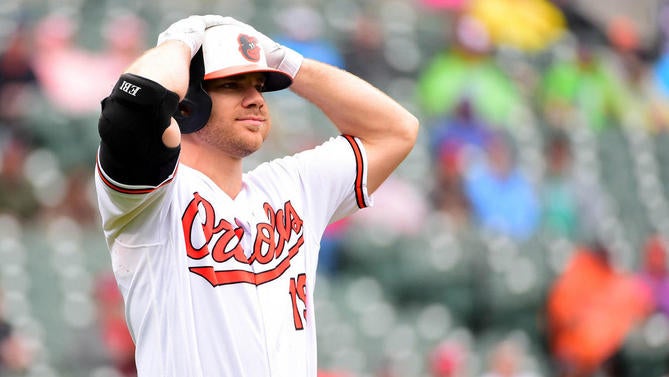Orioles' Chris Davis has a shot at baseball immortality -- and not in a good way
As we get set to celebrate the best players at the MLB All-Star Game, we should acknowledge the worst
The baseball world has gathered in Washington to celebrate the titans of the sport. The most powerful sluggers, most feared aces, and other standouts will all get to show off their talents in the 89th edition of the MLB All-Star Game.
But as we get ready to celebrate the best that baseball has to offer, we should also take a moment to acknowledge the worst. This season, Chris Davis has a shot at baseball immortality. And not in a good way.
Since the turn of the 20th century, two players shared the ignominious distinction of holding the lowest single-season batting average in major league history. In 1991, Rob Deer set a new record by managing just 80 hits in 448 at-bats, netting a .179 average. In 2013, Dan Uggla posted an identical mark of 80 hits in 448 at-bats, landing on that same hideous, well-below-the-Mendoza-line final line.
Chris Davis is on pace to undercut that record by more than 20 points. How he got here tells us a lot about how thoroughly the game has changed in the past few years.

Even with a slight downturn in home runs this season, we're still in a golden age for long balls. Juiced baseballs have stoked increased power production throughout the sport. You'll find that uptick in the expected places, such as hulking slugger Giancarlo Stanton falling just short of Babe Ruth's career high last season.
But the real eyebrow raisers have been the hitters who never showed tons of pop at the big-league level suddenly going on monstrous long-ball binges. Last year brought us eye-popping numbers for the likes of Logan Morrison, Justin Smoak, and even (for half a season anyway) the previously banjo-hitting Yonder Alonso. This season has brought more weirdness, including journeyman Max Muncy suddenly exploding on the league, becoming the fastest Dodger (by number of at-bats) ever to reach 20 home runs in a season. If you didn't know who Max Muncy was three months ago, you're in good company with pretty much everyone else, except the more die-hard seamheads, and maybe his mom.
What all these hitters have in common is a recognition that swinging for the fences can pay off big time, when the ball flies off the bat harder and further than it has in years ... and maybe ever. By that logic, Davis should be thriving. Five years ago, Davis went nuclear, crushing 53 homers, knocking in 138 runs, and slugging a massive .634.
That year, Davis refined his approach at the plate, becoming more selective, and learning to hit the ball to all fields. Beyond that more refined tack, Davis's modus operandi was painfully simple: Swing for the moon, and hope to connect. Years before "launch angle" become part of baseball fans' vernacular, Davis was the lord of the launch. When Davis bashed another 47 homers in 2015, the Orioles rewarded him with the richest contract (by far) in franchise history: A seven-year, $161 million megadeal.
Let's review what's happened since then:
- In 2016, Davis cranked another 38 home runs. It was also one of the least productive 38-homer seasons in MLB history, with the big first baseman batting a modest .221/.332/.459.
- In 2017, Davis played in just 128 games. His periodic absences certainly didn't hurt the O's, given that he batted an ugly .215/.309/.423. By wins above replacement, a catch-all metric that considers not only hitting but also baserunning and defense (neither of them strong suits in this case), Davis graded out as a replacement-level player -- the equivalent of the proverbial Quadruple-A guy who's too good for the minors but not good enough to earn a regular gig in the majors.
- This season, Davis is "hitting" a horrific .158(!!!!), putting him on pace to erase Deer and Uggla from the record books forever. As if that weren't bad enough, his power and batting eye have deserted him too, evidenced by his abysmal .232 on-base percentage and .274 slugging percentage.
- If we again go by wins above replacement, the holy grail of misery is a season that nets minus 4 WAR, meaning a player who cost his team four wins compared to your typical bench jockey. That's incredibly hard to do; so hard, in fact, that only one player has ever reached those subterranean depths: Jim Levey, a punchless shortstop who in 1933 capped his featherweight MLB career by batting .195 with two homers in 141 games, netting a mark of -4.0 WAR.
Pro-rating wins above replacement on an in-season basis is tricky for many reasons, one of them being the unlikelihood that a player performing as poorly as Davis will continue to nab regular playing time. Still, Davis currently sits at minus 2.4 wins above replacement, giving him a real shot at toppling Levey for the title of worst season in baseball history.
Oh, one more thing. With everyone from Logan Morrison to that guy you used to see at the batting cages on the weekend seemingly capable of launching 30-plus homers in this new, juiced-ball landscape, MLB GMs have recognized how easy it is to find power hitters in today's game, torpedoing their price on the open market. 2017 breakout mashers like Morrison and Alonso could garner no more than one-year guaranteed deals last winter, and they've fared a lot worse in 2018.
Meanwhile, Davis is only in Year 3 of his $161 million albatross deal. Meanwhile, to lessen the present-day financial burden, the Orioles deferred $42 million in payments as part of the contract. That means that Baltimore will be paying Davis through ... 2037. Today's Bobby Bonilla jokes will soon become Chris Davis jokes.
Speaking of compounding interest, you can explain Davis's struggles in part through the power of compounding at the plate.
When a hitter learns how to control the strike zone, the result is usually both a significant jump in on-base percentage, and more potent hitting. After all, if a hitter figures at which pitches not to swing at, he'll logically swing at tastier offerings instead, and meatballs down the middle naturally tend to get hit a lot harder than ankle-scrapers a foot off the plate. When said hitter starts smashing balls all over the park, pitchers become more leery of challenging him, leading to even more walks, leading to even better OBPs. And so on.
But if pitchers can figure out a way to exploit a hitter's weaknesses, that compounding cycle will turn in the opposite direction. First, pitchers will start generating more outs by attacking certain parts of the strike zone with pitches that our guy can't hit. Struggling and frustrated, the hitter's natural impulse will become to start swinging at pitches off the plate, hoping that something -- anything -- will start to click. The more frustrated and unselective a hitter becomes, the more a pitcher can further exploit him, until the hitter's performance completely collapses.

That's where we're at with Davis now. The 2017 and 2018 seasons have given us the two highest strikeout rates of his major league career. And when Davis does make contact, the results have been weak, including his lowest hard-hit rate and lowest home run-per flyball rate since way back in 2011, when he was a fringe player just trying to stick on a major league roster.
So what's been the silver bullet that's felled our former hero? Shifts. According to Baseball Info Solutions, opposing teams have slapped defensive shifts on 275 of Davis's 323 plate appearances this season. That 85.1 percent shift rate is the highest for any batting title-qualified hitter in the big leagues. As a result, on ground balls and short line drives hit into shifts, Davis is hitting a measly .163.
But even that number -- almost impossibly, one that's slightly higher than Davis's overall batting average -- doesn't tell the full story. Rotowire writer Jason Collette skillfully detailed the brutal effect that shifts have had on Bryce Harper this season. ESPN writer Jerry Crasnick took that train of thought even further, polling MLB veterans Daniel Murphy, Kyle Seager, and Matt Carpenter on how profoundly shifts can mess up even highly skilled left-handed hitters. As those three hitters noted, placing three infielders on the right side of the diamond can play tricks on a hitter's psyche. Try to hit the ball over the shift, and you might end up topping pitches into the dirt, or missing entirely. Try to guide the ball to the left side, and you'll often end up with an easy bouncer hit right to where the one defender on that side is standing. Beyond that, Carpenter told Crasnick:
"There's this whole narrative of 'Why don't guys just hit ground balls to short?' The answer is: (a) It's not that easy and (b) it's the complete thing you've taught yourself your entire baseball career to avoid. If a guy has a chance to hit a homer and a double, and he goes up there trying to slap a ground ball to short, the other team is perfectly fine with that."
This is the pit of despair in which Chris Davis now sits. Pitchers are aiming for the parts of the strike zone where he's weakest, trying to induce ground balls. Davis, staring at constantly overloaded defenses stacked up against him, is damned is he tries to pull the ball, and damned if he doesn't. As a result, Davis might break the all-time record for worst batting average in a season, and the worst overall season ever recorded in the game's history.
As for the Orioles, they're on pace for their worst season since 1910, since the franchise's miserable days as the St. Louis Browns...the same St. Louis Browns who employed Jim Levey, the same player who Davis might eclipse in the record books by season's end. And while the O's will very soon kickstart their rebuilding process by trading Manny Machado, Zach Britton and others for prospects, they'll be paying Davis for so long, your 2018 newborn will be a college sophomore by the time the paychecks stop.


















